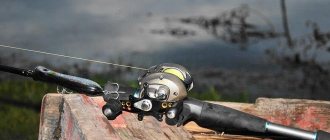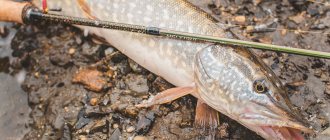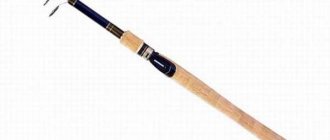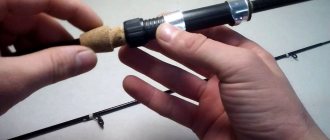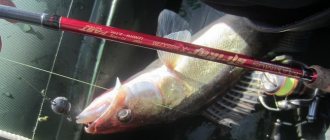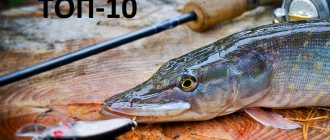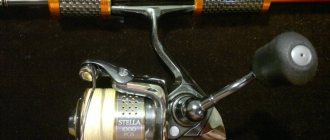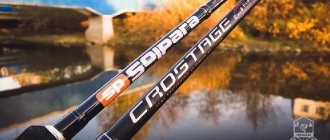What is casting spinning
The classic spinning rod has long been firmly established in the fishing world. A folding plug or telescopic fishing rod, guide rings for fishing line, various live and artificial baits: over a century and a half of using these attributes, Russians have become accustomed to considering the English invention theirs.
The time-tested rational tackle has nevertheless undergone changes. Casting spinning is fishing with a modernized fishing rod, the handle of which has a special protrusion - a rest for the fisherman’s thumb. The similarity of the stop with the trigger of a weapon gave the fishing rod another name - “trigger”.
Rodbuilding reel seat
The idea of a new fishing gear handle was implemented for more serious purposes - convenient use of a multiplier reel.
What is the difference between a casting spinning rod and a regular one?
The protrusion (trigger) is not the only technical feature of a casting rod. There are other differences in design and mechanics:
- The passage rings in such a fishing rod are located along the upper horizon. Casting spinning is like an inverted version of the classic fishing gear for athletes, professionals and amateur fishermen. Rings smaller than the usual diameter are held on short legs with amplifiers. Other fastening (drilling the blank) is prohibited, as it destroys the structure of the fishing rod’s body.
- The reel seat is also located on top of the handle, which allows for better control of bites and jerking retrieves. This is another difference between casting and spinning.
- The casting rod looks smaller: a comfortable, short handle makes the blank much lighter.
The high sensitivity of the gear combined with the ability to make long casts are the reasons why fishermen prefer casting.
But what a casting spinning rod is, the elements of the equipment will help you understand in detail.
Construction type
There are no special features in the structure of the casting rod, except for the handle. Choose a regular spinning stick. There are two types of folding fishing rods based on the method of fastening:
- Plug-in, consisting of several elbows. In this case, the sections are inserted into one another. When disassembled, the knees are separated. The plug connection makes the tackle light, sensitive and durable. You can install the rings according to the form at the distance you need.
- Telescopic, in which the sections slide into each other. The rings are located at the ends of the knees; you cannot change their location.
Only fishing rods with non-separable forms (single-piece) are superior to plugs in terms of sending power. In spinning fishing, two-piece rods are more often used.
Rod test
This is a characteristic of the power and strength of the stick, showing in what range or maximum limits the whip can be loaded with bait.
The English unit of measurement for dough is ounce, the Russian unit is grams. One ounce is equal to 28 g. The indicator is written on the form with two numbers, which indicate the lower and upper limits of the weight of the load.
Their classification is associated with the fishing rod test. There are the following categories with a maximum weight limit for complementary foods:
- ultralight – ultralight – 7 g;
- light – light – 15 g;
- medium-light – medium light – 25 g;
- medium – medium – 35 g;
- medium-heavy – medium heavy – 45 g;
- heavy – heavy – 60 g;
- super heavy – extra heavy – over 60 g.
Each class of fishing rods is used according to fishing circumstances. But the optimal tests for casting are 7-40 g.
Rod build
The whip flexibility parameter, or Young's modulus of elasticity, divides fishing rods into three main groups:
- fast action - only the tip of the fishing rod bends;
- medium action - half the stick bends under load;
- slow action - the entire form bends.
The stiffest rod with a slow action. Its advantage is that the form tactilely better conveys the moment of a bite, but you won’t be able to throw the feeder far.
Rod length
Casting fishing does not require casting distances of more than 100 m on reservoirs and lakes, so long forms are not needed. Choose a rod 1.5-2.5 m, rare cases require a blank length of 3 m.
Material of manufacture
If we do not consider wood and bamboo, the market offers three materials from which you can select a fishing rod:
- Carbon fiber (carbon) is a reliable flexible fibrous material, the most expensive in the segment.
- Fiberglass - costs less than carbon fiber, has lower characteristics. Advantage: light weight.
- Composite material is a budget option, halfway between carbon and fiberglass, suitable for beginners.
Materials, test, structure, and other parameters of the form do not fully explain the difference between spinning and casting. The casting technique gives a better idea of this.
Cord stiffness
The requirements for cords intended for casting (use in a baitcasting reel) are simple:
- ability to slide;
- abrasion resistance;
- moderate hardness.
Cords that have such properties retain their presentation for a long time, and, therefore, do not lose their breaking load. This cord lasts longer.
In casting fishing, the diameter of the braid is not particularly important. Using a multiplier allows you to use cords of any diameter, and beginners are recommended to use thick cords.
If in spinning fishing it is customary to use soft cords that allow you to deliver bait over long distances, then in casting such cords can only harm fishing.
The simplest and most affordable cord options are PE cords, which are made using hybrid technology. This cord has 8 cores (4 polyethylene, 4 polyester).
How to cast with a casting spinning rod
For a beginner, the matter will seem difficult, although you can master the casting technique in one fishing session. To understand what a casting spinning rod is and to appreciate its advantages, you need to start with a properly equipped fishing rod. For the first time, take an inexpensive rod, but a high-quality reel: with Chinese models you will be disappointed and will not learn casting fishing. There are exceptions to the rules here too: the Sharkey reel is an example of the excellent work of masters from the Middle Kingdom.
Start with a side cast of the bait, perform it powerfully but smoothly. Casting spinning means that your actions are both fast and not harsh. Work with medium weights: light and ultralight weights for experienced anglers. Make sure that the weight of the bait is 2/3 of the rod's weight.
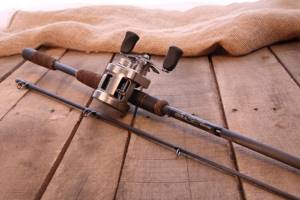
Casting stick with reel
When the side cast becomes confident, move on to a more delicate method - from behind the back. Make a powerful swing with the maximum load of tackle, then gradually reduce the speed of the swing, finally releasing the spool that you were holding with your thumb.
Some little secrets of spinning fishing
- Position of the spinner: the sun is shining in his face.
- Place the dead fish on the hook slightly above the side line - the line will work when retrieving.
- Fishing with a spinning rod in the form of a track, spinners, having secured several rods overboard, get into a boat and raft down the river.
- The pike is caught by its splash, having heard where it strikes, they throw the bait into that place. The pike sometimes stands near the shore; the most effective is fishing along the shore.
- The first casts should be made close to the shore, only then move on to long-distance casting of the bait.
- When fishing for asp, you should move the bait near the surface of the water, creating a stream. Asp are caught well on Devon. This predator is very strong, so both the rod and reel must be more powerful.
- The leader in the production of casting rods is called Abu Garsia. These are mainly budget products. These rods are suitable for beginners in spin fishing. The Ponton 21 company produces inexpensive castig fishing rods.
The leader in the production of casting rods is called Abu Garsia. These are mainly budget products. These rods are suitable for beginners in spin fishing. Ponton 21 also produces inexpensive castig rods.
In addition to a casting spinning rod, when fishing you need to have with you: a set of different baits, an extractor, one spare spool with fishing line, a knife, a fish bag.
How to choose a casting spinning rod
Even before going to the fishing store, decide what kind of wiring, bait and weights you intend to use: the tackle is selected for them. Make a choice in favor of the average test indicators and rod construction.
For jig
Jig is a method of moving bait in the bottom layers. Jig animation looks like this: you lower the wobbler to the bottom and create zigzag movements for it. Adjust the thread tension manually and watch the rod tip. The realistic game deceives the predator, and he swallows the bait along with the hook.
But you need to quickly respond to bites and hook your prey in time. Fishing is possible from the shore, but more effective - from a boat. The method makes it possible to feel the bite tactilely.
Use a universal stick length:
- 2.1 m - for short throws;
- 2.8 m – for long-range casting.
Select test up to 40 g.
For twitching
Casting fishing is designed for carnivorous bottom dwellers. Twitch – driving a wobbler with convulsive sharp movements that imitate the behavior of a wounded individual. It is good to use large minnows for these purposes.
Twitching can be monotonous, chaotic, rhythmic. The main thing is to give the predator the impression of easy prey through a cycle of jerks and pauses.
A fast action whip is suitable for this wiring. If you hunt from the shore, take a fishing rod up to 2.5 m long, from a watercraft - up to 2.1 m. Buy a lightweight tool with a fast action: your hands get tired from long-term playing. The required test is up to 30 g. Carbon fiber whips can withstand the dynamics of animation.
Good manufacturers of twitching rods and Salmo. Proven and reliable - Shimano, Kaida. Aiko products will not disappoint you either.
Jerky
“Jerking” translated from English means “twitch.” This is exactly what animation looks like – a series of chaotic convulsive jerks of varying strength. The impression that the fish is convulsing provokes predators to attack.
The method came from North America, where they fish from high boats or special platforms. The rods there are longer than those of our hunters who fish from low boats. The legs here are at the level of the water surface, so shorter fishing rods are needed - up to 210 cm.
Jerking gear is heavily loaded, and the weight of some baits is 180 g. But it is better to focus on the 40-120 g test. For heavy loads, fast and ultra-fast action is recommended.
Single-piece fishing rods are considered classic. They are inconvenient to transport to a reservoir, but the walls are thinner and the product weighs less, which makes long-term fishing easier.
Universal casting spinning rod
The Major Craft Dodger Series is suitable for twitching, jigging, jerrying and all types of artificial baits. Universal rods with a cork handle are sensitive, powerful, and made of carbon fiber.
The operating parameters are better demonstrated with weights of 15-40 g. The construction of the station wagons is fast, the length is up to 200 cm.
Your question to an expert
Leonid Grachev
Fisherman with a lot of knowledge and experience
Ask a Question
Description of the baitcasting reel
Inertial reels, a type of which multipliers have become, are characterized by poor controllability. Fishermen have mostly switched to progressive, inertia-free accessories.
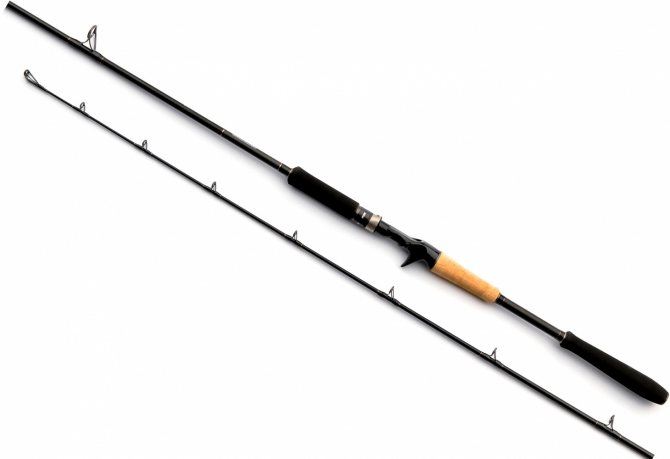
Casting rod
However, the modified multiplier products in the design received:
- gear mechanism of the winding drum;
- friction brake;
- device to prevent the line from coming off randomly.
Castine fishing with a spinning rod is a process that requires the use of an improved version of an inertial reel in the equipment. When casting such gear, tangling and “beards” are excluded.
Semi-closed body made of light but durable alloys. The center of gravity is in the area of the fisherman’s hand, which allows for wide improvisation in the methods of guiding the spoon. The reel is not intended for winter hunting and requires careful handling and systematic maintenance.
Selection of casting spinning rod by type of fish
Cautious and strong predators of Russian water bodies are desirable prey for fishermen. Fishing with a casting spinning rod is aimed at carnivores. You can fish with universal tools. But each individual has its own character and habits, so it is better to choose specific gear for each specific fish.
Pike
Half of the success in catching pike depends on the right tackle. However, fishing from the shore differs from the trolling method, hence the specifics in choosing equipment:
- Whip length. If you are fishing from the shore, you need a cast of up to 70 m. Take a stick of at least 3.5 m. From a boat, the distance is reduced, so a rod of 1.8-2.5 m is sufficient.
- Test. Considering that the toothy huntress does not like strong currents, select a weight for her of up to 40 g.
- Build. Pike goes jigging and twitching. This requires fast and ultra-fast fishing gear.
The material depends on your desires. Don't give up on composite fishing rods, especially if you are a beginner.
Asp
Suspicious fish with keen eyesight quickly notice the catch, so carefully camouflage tackle and bait. You won’t find an asp near the shore; for successful fishing you will have to cast often and far. Hence the parameters of the baitcasting fishing rod:
- length – 2.8-3.2 m;
- build – medium and fast;
- test – 25-30 g;
- bait - jigs, spinners, wobblers, castmasters.
Do not forget about a strong fishing line: the asp provides powerful resistance.
Zander
Look for the inhabitant of fresh and slightly salty waters in clean places: fast-flowing rivers, deep holes with a hard bottom. For voracious pike perch, offer jig wiring, foam rubber and silicone wobblers with recesses.
Assemble a specific fishing kit taking into account:
- high sensitivity;
- large margin of safety;
- sufficient rigidity;
- range.
To do this, you need a form up to 2.8 m long (from a boat - 2.1 m), with a fast action. The weight of the bait is enough for 15-40 g. All parameters are met by spinning rods of the “Gancho” series under the GAD brand.
Perch
The tenacious fish prefers northern cold waters and southern rivers. Perch's favorites are microjig (bait weight less than 5 g), miniature spinners and twitching.
A new type of fishing is quickly gaining popularity - nanojig. Lures weighing less than 1 g turned out to be catchy for finger-sized specimens. The tenacity with which a little thing fights for life evokes respect.
The weight of the prey rarely exceeds a kilogram, so a light and ultra-light fishing rod with a fast action and a test weight of up to 14 g is sufficient. Use braid 0.1 mm in diameter, fishing line - 0.15-0.2 mm. Blank length: for fishing from the shore - up to 270 cm, from a boat - up to 240 cm.
Casting fishing for some types of fish
Catching bream using a spinning rod is not as important as catching a predator, because it only fishes for a couple of weeks a year, when the fry are in season. With a casting rod, catching bream is possible using a rotating spoon with a yellow petal. It is advisable to disguise the triple hook with cambric and red threads.
The optimal rod for casting bream fishing is Shimano Crucial 66MH with a test range from 7 to 21 g. The one-piece blank is quite powerful, allows you to make decent casts, and most importantly, it very clearly controls the control of the bait.
It is also quite easy to choose a fishing rod for casting chub fishing. You can choose the Grafitleader line or the more budget-friendly Basspara. In small bodies of water, especially those blocked by a dam, where schools of chub are found, crackjack fishing will be successful, fishing in the upper water horizon.
Grayling is caught using a casting rod using various baits. If the fish is not large, rotating spinners with the number two zero are enough. It is also possible to use large ones, provided that the bite is good and there are a lot of fish in the reservoir. Wobblers with a half-meter immersion depth are used in the current, the main thing is that they are not thrown to the surface.
When fishing from a boat, the rod for casting grayling fishing does not exceed 180 cm; when fishing on shore, you can use a fairly long one, up to three meters. The action is medium or fast, the reel is, naturally, a multiplier, with a line of 0.1 mm.
Catching ide with a casting rod is very rare; they prefer to fish it with a spinning rod. But in any case, a soft whip is more appropriate, because the asp’s mouth is not very strong. Casting is selected for both jig fishing and twitching.
Small spinners have proven themselves to be quite good and should have:
- Required weight for long casting.
- Extremely easy move.
- Small size.
- The ability to maintain a level without falling into a tailspin.
A fishing rod for casting silver carp should be more powerful. The fish has a fighting character and is able to jump out of the water quite high. Fishing for it is a long and complex process that requires some creativity. It is not easy to lasso a silver carp; you need a properly selected fishing rod and good equipment.
It is impossible to find a fishing rod for casting sabrefish, which is what novice anglers are interested in so much about. You can achieve a bite from this fish only with the use of a float or sbirulino equipment, which we wrote about in the article “Bombarda: catching a predator on a spinning rod with ultra-light baits.”
Advantages and disadvantages of casting spinning rod
The design features of the fishing rod give fishermen new opportunities. When choosing - casting or spinning - the differences will play a decisive role in favor of the first.
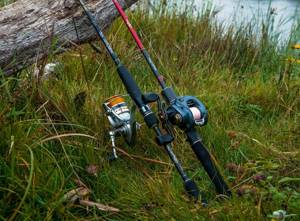
Casting spinning rod for jigging from a boat
The main advantage is at the very point of support for the thumb.
The trigger helps:
- hold the rod more confidently;
- carry out accurate casts;
- provide an interesting game of dummies;
- catch prey in time;
- To catch a predator for a long time without getting tired.
Casting is characterized by increased ergonomics and sensitivity of the spinning rod: information about the bite is transmitted to the angler’s hand. There are no restrictions on wiring methods and types of bait. The victim can be from minuscule to trophy sizes.
Fishermen consider the disadvantages to be the high price of specialized tools and the inability to work at extremely long distances.
How to fish with a casting microjig
Another type of spinning fishing, casting microjig, is increasingly gaining popularity. The use of a small multiplier reel on the lightest rod, fixing the cord with your fingers, makes a big difference from a conventional spinning rod. The main places for fishing in this way are small rivers, streams, toad ponds, oxbow lakes...
You can fish with casting everywhere, including in the smallest body of water where there is fish, in places that fans of large spinning rods and float fishing avoid. This gives you the opportunity to be alone with nature, catch unafraid fish, and always be with a good catch, the capture of which with the help of thin gear is never without adrenaline.
You can fish with miniature wobblers and spinners, but perhaps the most popular are jig baits. The result is a casting micro jig - a great way to make fishing fun and still catch everywhere.
There are many distinctive features in this business and to achieve success...
Casting microjig has its own characteristics
So, we have a microjig with a multiplier reel, which gives much more vivid impressions than conventional meat grinding equipment. We can pass the braid between our fingers. Now the bite is transmitted directly to the hand without an intermediary - the rod blank.
No matter how high-quality the rod is, it still kills information content.
There is no need to choose a particularly sensitive graphite blank, so the eternal problem of selecting a fishing rod for the best sensitivity goes away on its own.
This method of fishing requires some mastery of new techniques. Casting with a multiplier reel, although special, is very simple. Also, when you hold the rod by the front part of the handle and pass the cord between your fingers, it becomes much more difficult to control the bait with the rod.
The way out of the situation mainly lies in selecting baits with a bright game of their own. In any case, this is not critical for the catchability of the entire method.
The following are recommendations for selecting a casting microjig fishing kit - which rod, reel, cord and rigs to choose.
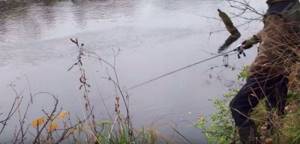
Selecting a rod for casting microjig
The conditions are as follows: you need to cast a bait weighing 3 - 5 grams with a rod with a multiplier reel. This will not work with a very rigid form.
A rod with a parabolic or semi-parabolic action would be preferable. But they are completely bad for jig animation - they give a lot of unnecessary vibrations. The solution is compromise.
A casting form is required - hard, with a medium-fast action, but with a fairly soft tip. Thanks to the tip, casting ultra-light baits will be possible, and the possibility of jigging is also preserved.
You should not use casting rods designed for bass fishing - they are short and stiff. Therefore, they work normally with baits no lighter than half of their test range, and are not suitable for casting microjigs up to 5 grams.
Selecting a casting rod for animating such light jig baits is not easy. It is advisable to first test it on a reservoir with the permission of the trading organization.
But you can also pick up a regular spinning rod and convert it yourself to a multiplier reel, which is not difficult. There are also small companies that will help you do this for a very reasonable fee.
A long rod will be inconvenient. Fishing involves moving along a river through the wilds and casting "from under a stump." Every extra centimeter in such conditions takes its toll. Therefore, it is better to choose an option that folds out of 3 - 4 parts, so that when carrying it you will be somewhat free from guarding the precious form. The recommended total length is about 1.7 meters.
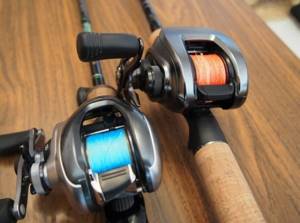
How to set up a multiplier for microjig fishing
The rod is equipped with a multiplier reel, which is capable of working with a weight of 2 (two!) grams. By the way, now you can choose a very inexpensive version of a miniature baitcasting reel of satisfactory quality, imported from the Far East.
The brake of the multiplier reel must be optimally adjusted to the gear. You can do this in the following way. You need to raise the tip of the rod. If the reel starts to spin under the weight of the bait, you should tighten the axial brake. Then raise the bait again and slow down until the reel begins to rotate too slowly, and when the bait hits the ground, it stops immediately.
Next, the magnetic brake is adjusted. First you need to put it in maximum braking, then make several casts. If loops do not form, then you need to release the brake a little and cast again, repeat the release until loops begin to appear. As soon as the coil loops, increase the braking force slightly. That's all - the baitcasting reel is configured for this gear.
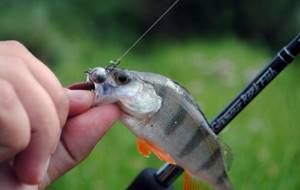
Which braid to choose for a casting microjig?
The characteristics of the braid vary primarily depending on its design. 8-core cords are softer, which has a positive effect when casting ultra-light baits. But, unfortunately, on a multiplier, excessive softness and slipperiness are not suitable - there is too much confusion, which actually disrupts fishing.
It is better to use 4-core, stiffer cords, which behave much more compliantly with multiplayer. In addition, due to the thick thread, they are more resistant to abrasion, last longer, and are also cheaper.
As for the thickness of the cord, it should be in the range of approximately 0.128 - 0.148 mm (0.6 - 0.8 according to the Japanese classification). There is no need to thin it too much to avoid confusion.
]The cord should be bright and colorful.
Winding the cord onto the spool of the baitcasting reel should be done with slight tension, holding the wound cord with your fingers. But for this you must wear gloves.
With the cord you need to use a leash, the most acceptable option of which is thin fluorocarbon. But it is often cut off by pike teeth. If you are fishing for pike purposefully, you need to use a thin steel wire.
Features of installations for microjig
Mounting the jig bait can be done either on a regular single hook or on an offset hook. Naturally, with an offset machine there are an order of magnitude fewer hooks, and in oxbow lakes and streams it becomes the main option.
But with it there is less detection, so if possible, it is better to use a single rod No. 6 -10. To make the bait slide less off such a hook, use instant glue on the fore-end. With an offset bait, it is better to use baits that bend easily when bitten, with a thin, non-elastic body.
Collapsible weights for microjigging are more convenient to use.
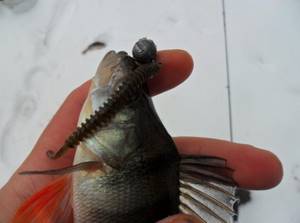
Jig baits for casting fishing
Regular (non-edible) silicone, as a rule, lasts much longer and stays on the hook better. This advantage is already enough to at least not be forgotten about.
When fishing with a casting microjig, the odor of the bait is not always a decisive factor. After all, there are enough active fish according to fishing conditions; accurate and fast fishing is more important.
The running size of silicone bait for casting microjig is about 2 inches.
Wiring is a regular jig step of 2 - 3 turns with the multi handle and a pause of a few seconds.
One of the design features of silicone baits, which makes them noisier and more noticeable (which is more important for casting fishing), is the presence of many transverse ribs.
However, all baits have their own bells and whistles to achieve the best catchability. Selection and search for catchable bait with such a variety of them is the task of the spinning fisherman. Here, specific recommendations will be more of an advertisement, because each bait in “other hands” will behave differently and may lose its catchability.
Having equipped yourself with gear with a multiplier reel for microjig fishing, you need to go to the reservoir. There the predator will stand at a depth under a cliff, or aground along the border with thickets, or in places with a sharp change in depth... Fishing will certainly be successful. All that remains is to get out there more often.

